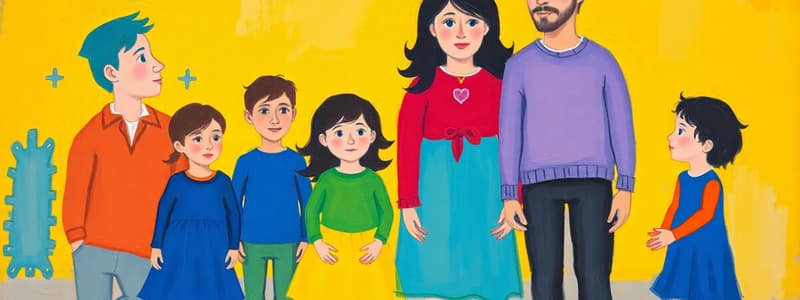Podcast
Questions and Answers
Which age range defines a toddler?
Which age range defines a toddler?
- 2 - 6 years
- 1 - 2 years (correct)
- 1 month - 1 year
- 12 - 18 years
What is a significant factor influencing the definitions of childhood according to the content?
What is a significant factor influencing the definitions of childhood according to the content?
- Religious practices
- Technological advancements
- Cultural beliefs (correct)
- Historical events
Which of the following describes the term 'satellite families'?
Which of the following describes the term 'satellite families'?
- Families physically separated for better opportunities while maintaining strong ties (correct)
- Families that are exclusively composed of step-siblings
- Families living together but with different last names
- Families that prioritize virtual communication over physical presence
What does the term 'economic dependency' refer to in the context of childhood definitions?
What does the term 'economic dependency' refer to in the context of childhood definitions?
What trend has been observed regarding family structures over time?
What trend has been observed regarding family structures over time?
Which family type has been acknowledged as a recognized family form since the 2006 Canadian census?
Which family type has been acknowledged as a recognized family form since the 2006 Canadian census?
What primarily causes variations in definitions of childhood across cultures?
What primarily causes variations in definitions of childhood across cultures?
Which term refers to families where parents live abroad while children remain in their home country?
Which term refers to families where parents live abroad while children remain in their home country?
What is a key characteristic of Canadian families according to recent findings?
What is a key characteristic of Canadian families according to recent findings?
What does the term 'chain migration' refer to in the context of Canadian families?
What does the term 'chain migration' refer to in the context of Canadian families?
How has modernization influenced family structures?
How has modernization influenced family structures?
Which of the following accurately describes Canadian immigration policy historically?
Which of the following accurately describes Canadian immigration policy historically?
What impact did high infant and maternal mortality rates have on families?
What impact did high infant and maternal mortality rates have on families?
Which factor contributed to changing definitions of family in modern times?
Which factor contributed to changing definitions of family in modern times?
How are families considered in terms of their roles in society?
How are families considered in terms of their roles in society?
What change occurred regarding traditional family functions?
What change occurred regarding traditional family functions?
What demographic change contributed to the smaller size of Canadian families?
What demographic change contributed to the smaller size of Canadian families?
How did the First World War impact women's roles in society?
How did the First World War impact women's roles in society?
What was a characteristic of childhood during Canada's Century?
What was a characteristic of childhood during Canada's Century?
What significant welfare measure was introduced in Canada in 1944?
What significant welfare measure was introduced in Canada in 1944?
The 1921 census revealed what trend regarding marriage in Canada?
The 1921 census revealed what trend regarding marriage in Canada?
What was one of the main reasons for the existence of single-parent or blended family households during this time?
What was one of the main reasons for the existence of single-parent or blended family households during this time?
What demographic changes were noted between 1921 and 1931 in Canada?
What demographic changes were noted between 1921 and 1931 in Canada?
What did the Reconstruction interlude after the Second World War emphasize?
What did the Reconstruction interlude after the Second World War emphasize?
What significant demographic change occurred after World War II, often referred to as the Baby Boom?
What significant demographic change occurred after World War II, often referred to as the Baby Boom?
Which factor was identified as the single most important influence on families during the post-war era?
Which factor was identified as the single most important influence on families during the post-war era?
How did the legalization of same-sex marriage in Canada impact family structures?
How did the legalization of same-sex marriage in Canada impact family structures?
What societal shift characterized the generation gap during the post-war period?
What societal shift characterized the generation gap during the post-war period?
What role did the availability of female contraception play in shaping family dynamics?
What role did the availability of female contraception play in shaping family dynamics?
Which trend was observed in the family structure by the millennium?
Which trend was observed in the family structure by the millennium?
What was a consequence of changes to the Divorce Act in 1968?
What was a consequence of changes to the Divorce Act in 1968?
What impact did the influx of married women into the labor force have on family configurations?
What impact did the influx of married women into the labor force have on family configurations?
What is the main characteristic of authoritarian parenting?
What is the main characteristic of authoritarian parenting?
Which parenting style is characterized by the constant support of adult children?
Which parenting style is characterized by the constant support of adult children?
What concern was raised about children in the 2000s?
What concern was raised about children in the 2000s?
Which parenting style is associated with balancing under-parenting and over-parenting?
Which parenting style is associated with balancing under-parenting and over-parenting?
How is intensive parenting ideology primarily characterized?
How is intensive parenting ideology primarily characterized?
What type of advice did child-rearing experts claim could influence a child's brain development?
What type of advice did child-rearing experts claim could influence a child's brain development?
What is a potential negative consequence of permissive parenting?
What is a potential negative consequence of permissive parenting?
Which of the following is a recommendation of attachment parenting?
Which of the following is a recommendation of attachment parenting?
Flashcards are hidden until you start studying
Study Notes
The Concept of 'Periods of Development' is Arbitrary
- The concept of 'periods of development' is based on social constructs.
- There are cross-cultural variations and similarities in how childhood is defined.
- Childhood is defined based on chronological age, level of maturity, physical maturation, and economic dependency.
The Changing Landscape of Canadian Families
- The traditional nuclear family (father, mother, and children) is declining in prevalence.
- There is an increase in blended families, same-sex families, transgender families, common-law couples, and lone-parent families.
- Satellite families (satellite children) have emerged in the 1980s, describing families with members living separately across borders due to economic opportunities.
Historical Evolution of Canadian Families
- Modernization has impacted family structures, accelerated by transportation and communication advances.
- Chain migration in the early 20th century led to the emergence of new Canadian families primarily from Europe.
- Traditional family functions, like childcare and education, were increasingly taken over by institutions like the church, charities, and later, the state.
- High infant and maternal mortality rates negatively affected families.
- Canadian immigration policy was historically racially exclusive, excluding families from countries outside of Western Europe and the US.
Families in the 20th Century: Key Trends
- Canada's Century (the century of the child): Childhood became a special life-stage associated with play, education, and character development, rather than work and wages.
- Divorce was difficult for women and highly stigmatized.
- Single-parent and blended households were primarily the result of the spouse's death, not divorce.
- Women gained access to paid employment, higher education, and involvement in female organizations, increasing their public presence.
- The First World War accelerated women's entry into paid labor and their public involvement.
- The Canadian Council on Child and Family Welfare was created in 1920.
- The 1921 census showed a higher proportion of married Canadians than ever before.
- A decline in the birth rate between 1921 and 1931 indicated the spread of birth control despite its illegality.
- Demographic changes: longer life expectancy, smaller family size, and longer marriages.
- The Great Depression negatively impacted family welfare programs.
- The Family Allowance Act (1944) aimed to provide financial support to families with children, particularly during and after WWII.
Families at Mid-Century
- The post-WWII Reconstruction period saw renewed focus on the family.
- A rise in divorce rates followed the return of veterans from the war.
- Post-war economic prosperity led to an increase in birth rates (the Baby Boom).
- The generation gap between youth and their elders emerged, embodied in the "hippie ethic" challenging social norms and embracing open marriage and communal living.
- This era saw advances in the status of women, with higher-paid work opportunities, increased life expectancy, and the 1968 Divorce Act making divorce easier.
- There was an influx of married women and mothers into the labor force.
Families at the Millennium: Changes and Challenges
- Declining fertility rates and an increase in "childless by choice" relationships.
- Increased life expectancy meaning a smaller portion of life is dedicated to childcare.
- Higher percentage of working mothers in the paid labor force.
- State-supported parental leave in the 1990s helped accommodate families with working parents.
- Legalization of same-sex marriage in 2005.
- Declining percentage of married-couple families.
- Increase in the percentage of common-law couples.
- The male breadwinner family model is becoming the minority.
Intensive Parenting: Its Impact on Families
- Intensive parenting, based on the assumption of ample time, money, and support for children, is primarily a middle-class ideal.
- It emphasizes close parental involvement, expert advice, and risk-management.
- Less privileged families may struggle to meet the expectations of intensive parenting.
- Concerns have arisen about the potential for over-parenting to lead to a generation of over-scheduled children without resilience.
- The need for balance between under-parenting and over-parenting is crucial.
Parenting Styles and Their Impact
- Authoritarian parenting: focuses on control and rules.
- Authoritative parenting: involves rational discussions and guidance. Authoritative parenting has been shown to positively impact children.
- Permissive parenting: allows children to largely follow their own impulses.
Newer Parenting Styles
- Attachment parenting: emphasizes close physical contact, breastfeeding on demand, and co-sleeping.
- Helicopter parenting: involves constant support and intervention in adult children's lives, potentially negatively impacting their well-being.
Conclusion: Diversity and Complexity in Canadian Families
- Canadian families are characterized by diversity and change.
- Definitions of family continue to evolve, reflecting shifting social attitudes, economic trends, and legal and policy changes.
- Theoretical and research approaches need to adapt to these evolving family dynamics.
Studying That Suits You
Use AI to generate personalized quizzes and flashcards to suit your learning preferences.




